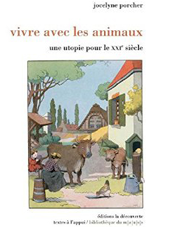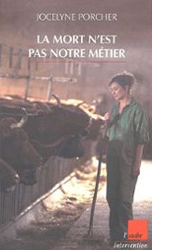et illustration
Aurélie Verdon
Direction technique et Intégration
Mehdi Mahjoub
Conception et rédaction
Jocelyne Porcher
Photographies
Philippe Deschamps
Publisher: Éditions du Palais
Co-authors: Elisabeth Lécrivain, Sébastien Mouret, Nathalie Savalois
Preface: Elisabeth de Fontenay
Date of publication: 2014
Humans and farm animals build strong physical ties during the animal’s life. The beginning of the book reminds us of this essential truth.These ties are severed by the death of the animal. Thanks to industrialisation, standardisation and necessary health and safety measures, farmers no longer have access to the slaughter of their own animals, or to the moments preceding entering the abattoir that the animal which they have bred and cared for lives through. The farmer is sometimes indifferent, but more often, feels frustration at not having ownership of this final “human-animal” relationship. This text perfectly illustrates this frustration, particularly where it deals with the accounts of actors describing it. Researchers express themselves clearly on the subject, and their words are complimented by extremely well designed illustrations that explain the manifesto. Further reading here: Livre Blanc – Boria Sax

Publishing : Quae Released
Date of publication: 2011
Bullfighting : we are for or against , there is no middle ground . Moving away from this dichotomy , the author considers bullfighting in terms of working with animals . Can bullfighting without death ?
 Vivre avec les animaux,
Vivre avec les animaux,Publisher: La Découverte/MAUSS
Preface: Alain Caillé
Date of publication: 2011
In our radically artificialized world, only animals will remind us what nature was, and perhaps allow us to remember our real humanity, but will we know how to live with them? Do we still want to? For the mass slaughter of animals that is considered to be a simple element of “animal production”, inflicts insupportable suffering and terror on them, to the despair of farmers. Moreover, animal husbandry, after 10,000 years of existence, is now often thought of as a nuisance, to the environment as well as to our health. This condemnation rests on a confusion between “animal husbandry” and “animal production”, so it is necessary to understand the complexities therein. What is animal husbandry? What are the differences between “animal husbandry” and “animal production”? What place does death have in work with animals? Can we improve their exit in industrial systems? Must we “liberate animals”, as advocated by some philosophers? Through addressing these questions, Jocelyne Porcher explains how the capacity for man to coexist peacefully depends on their capacity to live in peace and dignity with animals, and why, therefore, saving animal husbandry by sparing it from subjection to a system of exploitation and an industrial way of death could be one of the most beautiful utopias of the 21st century.
 Cochon d’or, l’industrie
Cochon d’or, l’industriePublisher: Quae
Date of publication: 2006
Far from the idyllic image of a little farm in children’s books, these days pigs in their millions are processed in the pork industry. Taking into account the radical transformations in this field, what is work? What is it not?

Publisher: La Découverte
Adapted and performed by the Art etc. theatre company,
from 2010 to the present.
Date of publication: 2008
“I like pigs, even though I am still a young girl, as I am constantly reminded when adults want to stop me doing things that only
they can do. I like them. I have a lot to say about pigs.” For Solenn, life is strange. Solenn, whose mother Morgane works in an industrial pig farm, who is less rosy than the pigs that she frequently visits while watching her mother work, and more peculiar than adults seem to give her credit for, watches adults dealing with gruelling daily work through the eyes of a child. But, through the eyes of a child, the authors of this tale say far more than all the official reports on the horrifying and absurd reality of industrial agriculture and the state of our relations with animals do. “Do we have total rights over animals?” asks Solenn. “There are times when I ask myself if it is we who are the savages”, answers Morgane. Ultimately, though farmers farm animals and eat meat, this is not without cost for them, or for their animals: “because we can be free together, or prisoners together, if is for us to choose.”
 Être bête (Being beasts)
Être bête (Being beasts)Publisher: Actes Sud
Co-author: Vinciane Despret
Date of publication: 2007
What is the difference between man and beast? Philosophers, psychologists, anthropologists and legal experts have endlessly wrestled with this question. What sense can they give to those who live daily with cows and pigs and create ties with them? What do farmers think? We discover unexpected answers when we listen to them. The animals they work with are intelligent and sensitive, they know what they want and they can divine what is expected of them. We have a primatology for monkeys and an ethnology for dolphins, bears, wolves, elephants and birds, but we still overlook nearly everything concerning cows and pigs. Their farmers, however, have a wealth of knowledge about them, knowledge which differs from the scientific, and which is rooted in “living together”. What is the difference between man and beast? Strange question!
 La mort n’est pas notre métier
La mort n’est pas notre métierPublisher: de l’Aube
Date of publication: 2003
La mort n’est pas notre métier is a book about farmers, farm animals and the rural world. From the first line, it plunges to the heart of this strange world, which is so little known these days: “Piggy is the perfect teaser boar. Its function is to arouse the sows”. Clear enough, but we learn immediately after that Piggy is a battery-operated machine, and understand that this text, beyond just sharing an immense knowledge of real life in the countryside, will lead us to reflect on what we have done to animals, and, at the most fundamental level, what we are doing to life – to our farm animals, as well as to ourselves.
 Bien être animal et travail en élevage
Bien être animal et travail en élevagePublisher: Educagri
Collection: Sciences en partage
Date of publication: 2004
Using the writings of specialists, legal documents and interviews with farmers, the author considers the notion of animal welfare from the perspective of the historical development of farming in the industrial society.
 nter le lien
nter le lienPublisher: Presses universitaires de France
Collection: Partage du savoir
Date of publication: 2002, Prix le Monde de la recherche universitaire
In less than fifty years, animal husbandry in France has been transformed into a set of “animal production” activities, which are identical to other forms of industrial production in their objectives and in the essentials of their methods. This change has been driven by the appliance of science, which has reduced animal husbandry to no more than its economic rationality, and has changed farmers into producers of goods of animal origin. If the quantitative success of this transformation is undeniable, its failure is equally so. Farmers reject the suffering, and testify to their attachment to their animals and the place of affectivity and communication in their work. To prevent the world from becoming an alienated and disenchanted place, within which “we produce pigs like we produce shoes” worldwide, and society becoming one in which neither the farmers nor their animals will soon have a place, we must collectively learn to work with farm animals differently, and re-invent the tie.